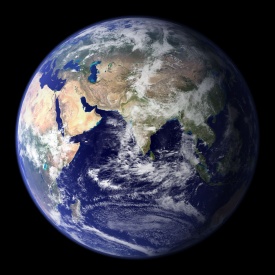Earth: Difference between revisions
Asid Mjolnir (talk | contribs) m (1 revision imported) |
Asid Mjolnir (talk | contribs) mNo edit summary |
||
| Line 34: | Line 34: | ||
*Primary Source of Information: [http://csc.gallaudet.edu/soarhigh/earth.html Gallaudet University] | *Primary Source of Information: [http://csc.gallaudet.edu/soarhigh/earth.html Gallaudet University] | ||
*Secondary Source of Information: [http://www.nasa.gov/audience/forstudents/9-12/features/912_liftoff_atm.html NASA] | *Secondary Source of Information: [http://www.nasa.gov/audience/forstudents/9-12/features/912_liftoff_atm.html NASA] | ||
[[Category:Planets | [[Category:Planets]] | ||
Revision as of 02:16, 26 March 2022
| Terra (Earth) | |
 | |
|---|---|
| Designations: | Sol 3 |
| Star System: | Sol System |
| Galaxy: | Orion Arm, Milky Way Galaxy |
| Condition: | Habitable |
| Atmosphere: | Nitrogen (%78) Oxygen (%21) Argon (%1) Carbon Dioxide (%0.1 - %0.01) Ozone (%0.01) Hydrogen (%0 - %7) |
| Surface Gravity: | 1 Standard G |
| Natural Satellites: | Luna |
| Control: | United Earth Forces (Former) None (Present) |
| Dominant Species Population: | 7 Billion (Peak) Unknown (Estimated to be <100 Million, Present) |
| Interest: | Homeworld |
- For the ship of the same name, see SFCV Terra.
Terra, more commonly known as "Earth" is the third planet in the Sol System (located within the Orion Arm of the Milky Way Galaxy), is the origin of Humanity. Earth's ecology was severely damaged following the Fall of Earth, with civilization being almost completely wiped out.
History
Earth, from when humans first evolved, 2017 CE, was the sole location that humans could be located. Because of a rapidly expanding population, and the numerous technological advances that relied on less than environmentally friendly methods, Earth's ecology rapidly began to degrade, in some areas becoming almost toxic to human life, with the world and its rapidly diminishing resources being fragmented between numerous nations. In 2019 CE, with the creation of the first extrasolar colony, which chose not to align with any nation on Earth, the major nations chose to unify to combat this potential threat. After numerous harassing attacks on colonial transports, the government of this new colony chose to build a fleet of warships, and waged a War of Secession that lasted almost a decade and a half. With the new colony winning the war, they chose to evacuate willing colonists, before initiating a quarantine of the planet, whose ecosystem had been devastated by ecological weapons, numerous orbital bombardments, and the detonation of at least one nuclear weapon within the atmosphere.
Following the end of the war and subsequent abandonment of the Sol System, Earth's viability as a human-habitable world has been in question. Estimates, based on the damage to the ecosystem, places Earth as an inhospitable world, likely supporting only a few tens of millions at most.
Details
- Orbits at 149.5 million km (92.9 million miles, 6 light minutes) from the sun.
- Takes light 8.3 minutes to reach Earth from it's nearest star, Sol.
- Has a year of 365.26 Earth days, each day lasting 23 hours, 56 minutes, & 4 seconds.
- 71% of surface is water, 29% land, subject to change.
- Escape velocity is 11.2 Km/s
- Has a diameter of: 12,756 km (7,926 mi)
- Surface Pressure: 1 Atmosphere
- Surface temp: Anywhere between -88 deg to 58 deg Celsius. (-126 deg to 136 deg Fahrenheit).
See Also
- Primary Source of Information: Gallaudet University
- Secondary Source of Information: NASA